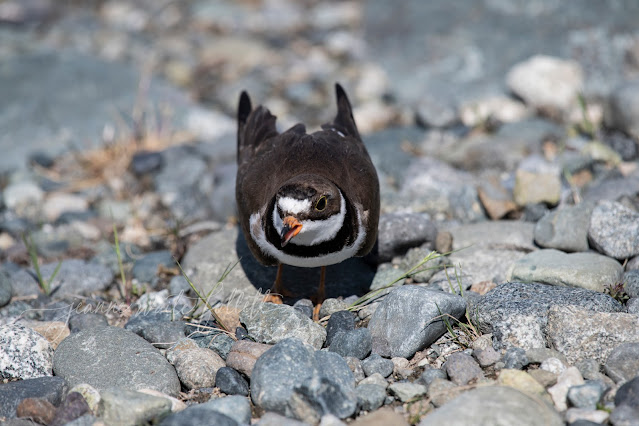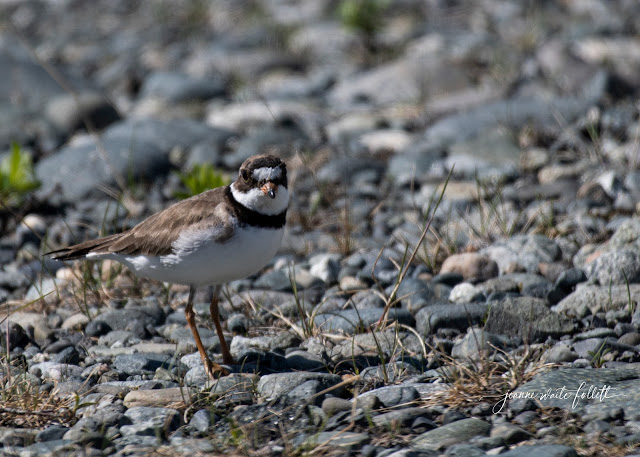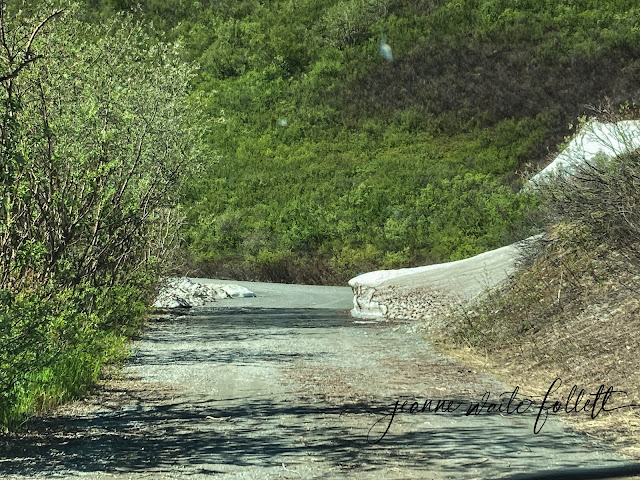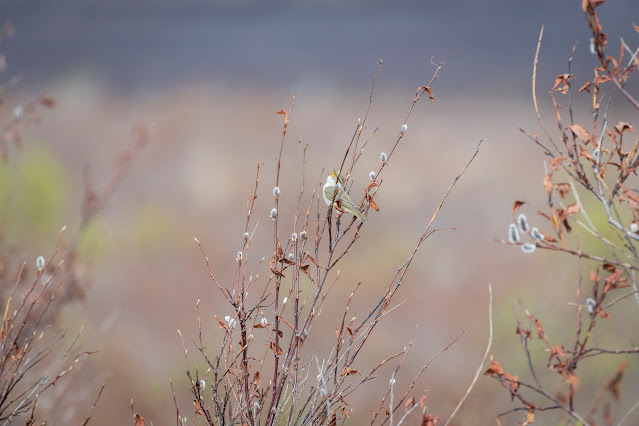The Third Day, Part Three
Specks in Bushes
"How ya doing, Carrie? " I ask Leilani's friend who is visiting from Florida. There's no answer.
She's in the front passenger seat and, when I look, she's gazing down at her lap. I realize she's reviewing photos on her camera. I ask again, "Carrie? How are your photos?"
A long pause and then, "Well...... I'm used to shooting big birds. Not little specks in bushes."
Flashes of the large birds of Florida--the cranes, herons, spoonbills, and the anhinga with its wings hung out to dry--come to mind. Then, I have to laugh because "little specks in the bushes are exactly what we're shooting. "Shooting" as in photographing.
Below is a full frame photo taken with a 500 mm lens. I'm about 25to 30 feet from the bird, as near as I can recall.
Not much of a photo, is it?
From that useless image, I crop it, tweak it to emphasize the bird, and BINGO! A perfectly usable photo of one of the birds we drive all this distance to see--an Arctic warbler singing its heart out while perched in the early spring pussy willows along the Denali Highway.
 |
Much better.
|
I don't know what lens Carrie is using, but it looks a lot lighter than the behemoths that Leilani and I are carrying. My main camera outfit weighs 8-1/2 lbs., and, at my age, it's a struggle to hold it still. If I'm in the truck, I brace it against the windowsill. If not, I try to use parts of the truck as a substitute tripod. A real tripod won't work here. The bird would be gone before I set it up. Plus, having a tripod attached to the camera doesn't allow for quick changes of direction as the bird flits about.
Occasionally, I use a monopod. That works fine except when it's constant in-the-truck, out-of-the-truck, and the camera has to be detached and re-attached from the monopod mount.
Finding a small speck in the bushes is the first step. Getting a lens on it is another.
 |
| Wilson's warbler |
Quite often, the below photo is what I get. Or tail feathers leaving the side of the frame. Or just bushes because the bird has flown.
Or, the most maddening, is when they perch in the open and hold still but their backs are turned toward us, like the orange-crowned warbler below.

So I understand Carrie's predicament.
By the way, we are using my crew cab mid-sized Dodge Dakota pickup for this adventure. The three of us can ride comfortably with a spare seat for gear and jackets. Leilani is driving, something I always let her do because if I drive, her screams hurt my ears.
Believe that? Actually, it's because of HER hearing. It is acute. She can drive with the window down and identify birds that chirp in the bushes. My contribution is vision, though I can tell I'm slipping in that regard.
If I drive and watched for birds at the same time, the truck will often follow my line of vision. By letting Leilani drive, we avoid many encounters with brush on the sides of the road.
Anyway, it works out well.
***
So, we're driving past a small lake when I spot a nesting gull. Normally, we don't stop for gulls but this one was sitting on an attractive nest. Then we realize the gull isn't alone. There's a pair of red-necked phalaropes in the lake, too.
We had checked a larger lake on the way in that usually has a large flock of phalaropes, so reliable that we call it Phalarope Lake, but there were none. It is apparent to me that we are a week or ten days too early and that spring is late in arriving. Many of the reliable places for waterfowl are vacant. Thus far, we have seen only one trumpeter swan.
 |
| Herring gull. |
 |
| Red-necked phalarope. |
Phalaropes are small shorebirds that migrate from South America to Alaska to nest and raise their young. They have a unique feeding habit that makes getting a clear photo of them difficult:
"Phalaropes are visual hunters. During the summer, their diet is principally freshwater insects and other invertebrates. The birds swim or walk in shallow water
or at pond edges and pick adult or larval insects (such as midges and craneflies) from the vegetation or the water. When feeding in deeper water, phalaropes
sometimes swim rapidly in a small circle and create a vortex. As food items are raised from the depths, the birds peck from the center of the circle.. "--Alaska Department of Fish and Game
Imagine trying to photograph a little bird that is spinning in circles.
 |
| The gull is waiting for us to move so it can return to its nest. Note the phalarope just below it. |
The gull left the nest and flew away when we got out of the truck. It soon returned and when we realize it is back and wants to regain its nest, we load up and depart, as always thanking the wildlife for the privilege of photographing them.
A couple more from this trip:
 |
| An American wigeon flapping its wings, one of the few waterfowl we found. |
 |
This cute little bird is a male yellow warbler. Keep in mind that the head and body of these warblers are about as large as a thumb, not counting the tail feathers.
|
 |
The second bird we drive all this way to see is the American Tree Sparrow. The first is the Arctic Warble pictured in a different post.
|














































